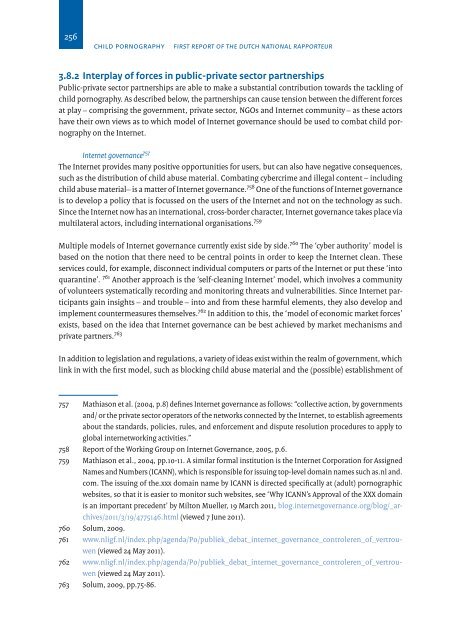Child Pornography - Home | National Rapporteur on Trafficking in ...
Child Pornography - Home | National Rapporteur on Trafficking in ...
Child Pornography - Home | National Rapporteur on Trafficking in ...
You also want an ePaper? Increase the reach of your titles
YUMPU automatically turns print PDFs into web optimized ePapers that Google loves.
256<br />
<str<strong>on</strong>g>Child</str<strong>on</strong>g> PornograPhy First report oF the Dutch NatioNal rapporteur<br />
3.8.2 Interplay of forces <strong>in</strong> public-private sector partnerships<br />
Public-private sector partnerships are able to make a substantial c<strong>on</strong>tributi<strong>on</strong> towards the tackl<strong>in</strong>g of<br />
child pornography. As described below, the partnerships can cause tensi<strong>on</strong> between the different forces<br />
at play – compris<strong>in</strong>g the government, private sector, NGOs and Internet community – as these actors<br />
have their own views as to which model of Internet governance should be used to combat child pornography<br />
<strong>on</strong> the Internet.<br />
Internet governance 757<br />
The Internet provides many positive opportunities for users, but can also have negative c<strong>on</strong>sequences,<br />
such as the distributi<strong>on</strong> of child abuse material. Combat<strong>in</strong>g cybercrime and illegal c<strong>on</strong>tent – <strong>in</strong>clud<strong>in</strong>g<br />
child abuse material– is a matter of Internet governance. 758 One of the functi<strong>on</strong>s of Internet governance<br />
is to develop a policy that is focussed <strong>on</strong> the users of the Internet and not <strong>on</strong> the technology as such.<br />
S<strong>in</strong>ce the Internet now has an <strong>in</strong>ternati<strong>on</strong>al, cross-border character, Internet governance takes place via<br />
multilateral actors, <strong>in</strong>clud<strong>in</strong>g <strong>in</strong>ternati<strong>on</strong>al organisati<strong>on</strong>s. 759<br />
Multiple models of Internet governance currently exist side by side. 760 The ‘cyber authority’ model is<br />
based <strong>on</strong> the noti<strong>on</strong> that there need to be central po<strong>in</strong>ts <strong>in</strong> order to keep the Internet clean. These<br />
services could, for example, disc<strong>on</strong>nect <strong>in</strong>dividual computers or parts of the Internet or put these ‘<strong>in</strong>to<br />
quarant<strong>in</strong>e’. 761 Another approach is the ‘self-clean<strong>in</strong>g Internet’ model, which <strong>in</strong>volves a community<br />
of volunteers systematically record<strong>in</strong>g and m<strong>on</strong>itor<strong>in</strong>g threats and vulnerabilities. S<strong>in</strong>ce Internet participants<br />
ga<strong>in</strong> <strong>in</strong>sights – and trouble – <strong>in</strong>to and from these harmful elements, they also develop and<br />
implement countermeasures themselves. 762 In additi<strong>on</strong> to this, the ‘model of ec<strong>on</strong>omic market forces’<br />
exists, based <strong>on</strong> the idea that Internet governance can be best achieved by market mechanisms and<br />
private partners. 763<br />
In additi<strong>on</strong> to legislati<strong>on</strong> and regulati<strong>on</strong>s, a variety of ideas exist with<strong>in</strong> the realm of government, which<br />
l<strong>in</strong>k <strong>in</strong> with the first model, such as block<strong>in</strong>g child abuse material and the (possible) establishment of<br />
757 Mathias<strong>on</strong> et al. (2004, p.8) def<strong>in</strong>es Internet governance as follows: “collective acti<strong>on</strong>, by governments<br />
and/ or the private sector operators of the networks c<strong>on</strong>nected by the Internet, to establish agreements<br />
about the standards, policies, rules, and enforcement and dispute resoluti<strong>on</strong> procedures to apply to<br />
global <strong>in</strong>ternetwork<strong>in</strong>g activities.”<br />
758 Report of the Work<strong>in</strong>g Group <strong>on</strong> Internet Governance, 2005, p.6.<br />
759 Mathias<strong>on</strong> et al., 2004, pp.10-11. A similar formal <strong>in</strong>stituti<strong>on</strong> is the Internet Corporati<strong>on</strong> for Assigned<br />
Names and Numbers (ICANN), which is resp<strong>on</strong>sible for issu<strong>in</strong>g top-level doma<strong>in</strong> names such as.nl and.<br />
com. The issu<strong>in</strong>g of the.xxx doma<strong>in</strong> name by ICANN is directed specifically at (adult) pornographic<br />
websites, so that it is easier to m<strong>on</strong>itor such websites, see ‘Why ICANN’s Approval of the XXX doma<strong>in</strong><br />
is an important precedent’ by Milt<strong>on</strong> Mueller, 19 March 2011, blog.<strong>in</strong>ternetgovernance.org/blog/_archives/2011/3/19/4775146.html<br />
(viewed 7 June 2011).<br />
760 Solum, 2009.<br />
761 www.nligf.nl/<strong>in</strong>dex.php/agenda/P0/publiek_debat_<strong>in</strong>ternet_governance_c<strong>on</strong>troleren_of_vertrouwen<br />
(viewed 24 May 2011).<br />
762 www.nligf.nl/<strong>in</strong>dex.php/agenda/P0/publiek_debat_<strong>in</strong>ternet_governance_c<strong>on</strong>troleren_of_vertrouwen<br />
(viewed 24 May 2011).<br />
763 Solum, 2009, pp.75-86.


